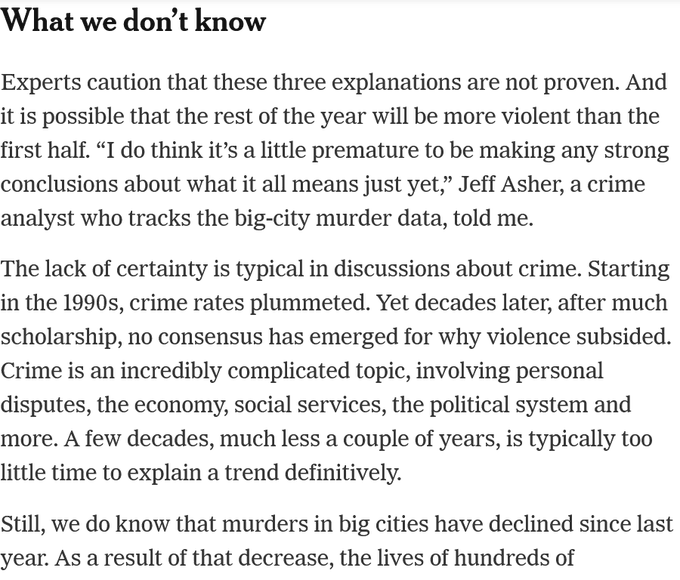I’ve been taking a summer break from writing new posts because I’ve been asked to turn my newsletter posts into a book on Copaganda. As with my last book, my plan is to donate all royalties to a community-based organization that fights against police violence, and to have free copies available to all teachers and to all high school, college, and graduate students who want them. We will also have free copies available to all people who want one and who are confined in jails and prisons, and to folks organizing in their community against police violence.
But I needed to send a post today because, once again, the New York Times has allowed one of its most notorious pro-police writers to publish yet another irresponsible article emailed to millions of paid subscribers in the NYT’s flagship “The Morning” newsletter.
Protesting for Civil Rights Causes MURDER and the Only Solution Is More Cops
Today’s article is a smorgasboard of copaganda, but I want to focus on two recurring themes. First, the author yet again baselessly claims that the George Floyd protests for racial justice and civil rights caused more murders. Second, the author yet again baselessly claims that more cops reduces violence. Each of these outrageous claims are supported by vague, anonymous reference to “experts, ” who are, again, portrayed as operating with some kind of consensus.
If you haven’t read it yet, this would be a good time for you to read my prior essay that dissects much of this unethical misinformation by this same reporter over the last several years, as well as all of the tactics used in this article:
How the New York Times Uses "Experts"
Journalists often need to explain complex concepts. One way that reporters and editors do this is by using “experts” to offer important context. There’s nothing wrong with using experts to help explain things. There are many issues in the world that matter for our lives, and we can’t possibly have the time or ability to master them all ourselves. And …
Here are some of today’s excerpts. You’ll notice that they are essentially identical to the practices criticized in the past—almost a carbon copy:
These arguments have been thoroughly debunked in every respect. But at the very least, they are highly controversial claims that many “experts” dispute. But not so for German Lopez and the New York Times—for them, the wide range of experts from economics, public health, history, anthropology, sociology, and law who have offered very different explanations and analyses are erased. After I called attention to this misinformation two years ago, the excellent non-profit Fairness and Accuracy in Reporting (FAIR) published a lengthy taketown. I and others have continued to highlight the ethical implications of this coverage for the New York Times, but also for the public’s trust in the media generally.
Indeed, something is different about today’s article. At the end of the article, for the small percentage of people who read the whole thing, there is a remarkable paragraph that essentially confirms that the rest of the article is speculation. Contrast the author’s earlier use of the term “likely” with what the article says about the theories not being “proven”:
The fact that the paper needed to insert the qualifications at the end but that editors still permitted the author to assert above that his speculation was “likely” is devastating to the paper’s credibility.
When this author used to work at Vox, he wrote similar pro-police nonsense, so I had a long conversation with him hoping to get him to see the need for more objectivity and critical thinking. It was very weird. He was unable to support basic, prominent assertions that he made in published articles, but was also unwilling to change. He merely referred me to a number of biased, cherry-picked studies that he and I both knew had been themselves debunked and that did not even, on their face, support the arguments he was making about needing more police. It was during that conversation I realized I was not dealing with a good faith actor seeking rigorous truth who was just misinformed, but an idealogue who, because his ideology is so thoroughly mainstream, has trouble even seeing his own biases. The question is: why does the New York Times allow him to continue reprinting essentially the same article every few months for years? The possible answers to that question are not heartening for the future of U.S. corporate media.
Two Other Observations:
I want to highlight how today’s misinformation plays into two other important themes that I’ve discussed. First, in The Volume of News, I explained that how, when, where, and how many times news outlets cover certain stories and say certain things is a huge element of propaganda. In addition to the volume of ordinary coverage, I specifically had in mind things not traditionally thought of as relevant, such as which stories outlets choose for push alerts to phones, which stories are featured on social media, and which stories are marketed to paying email subscribers. Read that piece here:
Also, I have highlighted an anti-intellectual trend at the NYT in which the elite newspaper permits a small range of ideologically homogenous writers to pontificate on a wide range of the most important issues in our society.











Talking to copbrained people has been a practice in futility for me. The notion that police aren't effective community safety is such an abstract idea to them. I get it, cops have been propped up in our society as the arbiter of good and evil, no matter how demonstrably untrue that is, that it's very hard for people that maybe have never interacted with them to see them any different. Your work is a fantastic dive into how our minds have been gaslit to see LE as a societal good, while their unwarranted violence is recorded so thoroughly. Thank you! Can't wait to read the book version.
I’m thrilled to hear you’re writing a copaganda book!